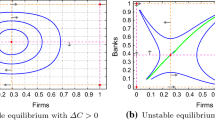Abstract
Following the bankruptcy of Lehman Brothers, world financial markets went through a period of economic anarchy in the latter half of 2008. Particularly in October 2008, many world stock exchanges introduced circuit breakers and frequently changed rules for implementing them. In the viewpoint of those who emphasize autonomy and efficiency of markets, these rule changes must be incomprehensible. In order to understand the institutional changes in stock markets, we introduce “replicator” and “interactor” which are key concepts of institutional and economical evolution. We show that market mechanisms such as circuit breakers were formed through evolutionary dynamics motivated by environmental changes in addition to economic efficiency. We maintain that the concepts of replicator and interactor help in understanding institutional evolution.
Similar content being viewed by others
References
Brady, N. F. (1988) Report of the Presidential Task Force on Market Mechanisms, Government Printing Office: Washington, DC.
Brennan, M. J. (1986) “A Theory of Price Limits in Futures Markets,” Journal of Financial Economics 16.2: 213–233.
Fama, E. F (1989) “Perspectives on October 1987, or What Did We Learn from the Crash?” in R. W. Kamphuis, Jr., R. C. Kormendi, and J. W H. Watson (eds) Black Monday and the Future of Financial Markets, Dow-Jones-Irwin, Homewood, IL, pp. 71–82.
Harris, L. (1998) “Circuit Breakers and Program Trading Limits: What Have We Learned”, in: R. E. Litan, A. M. Santomero (eds) Brookings-Wharton Papers on Financial Services. Brookings Institutions Press, Washington, DC, pp. 17–63.
Kim, K. A. and S. G. Rhee (1997) “Price Limit Performance: Evidence from the Tokyo Stock Exchange,” Journal of Finance 52.2: 885–901.
New York Stock Exchange “Rule 80B” http://www.nyse.com/press/circuit_breakers.html (Retrieved April 30, 2010).
Nihon Keizai Shimbun (1998) “Revision of Circuit Breaker in NYSE (in Japanese)”. (1998, February 14).
Nishibe, M. (2006) “Rules and Institutions in Evolutionist Institutional Design (in Japanese),” The economic studies (Hokkaido University) 56.2: 133–144.
Osaka Securities Exchange (2008, November 25) “Rule Amendments for Circuit Breakers on Stock Index Futures”, http://www.ose.or.jp/e/profile/pr_data/pr_081125.pdf (Retrieved October 10, 2009).
Osaki, S. (1998) “Revision of Circuit Breaker in America (in Japanese),” Capital Market Quarterly, Winter, Nomura Institute of Capital Markets Research.
Subrahmanyam, A. (1994) “Circuit Breaker and Market Volatility: a Theoretical Perspective,” Journal of Finance 49: 237–254.
Tokyo Stock Exchange (2008, November 25) “Change of Circuit Breaker Rule on Index Futures,” http://www.tse.or.jp/english/news/200811/081125_b.html (Retrieved October 10, 2009).
Author information
Authors and Affiliations
Corresponding author
Additional information
Research fellow of the Japan Society for the Promotion of Science (JSPS).
About this article
Cite this article
Kobayashi, S., Hashimoto, T. Analysis of Institutional Evolution in Circuit Breakers Using the Concepts of Replicator and Interactor. Evolut Inst Econ Rev 7, 101–111 (2010). https://doi.org/10.14441/eier.7.101
Published:
Issue Date:
DOI: https://doi.org/10.14441/eier.7.101




